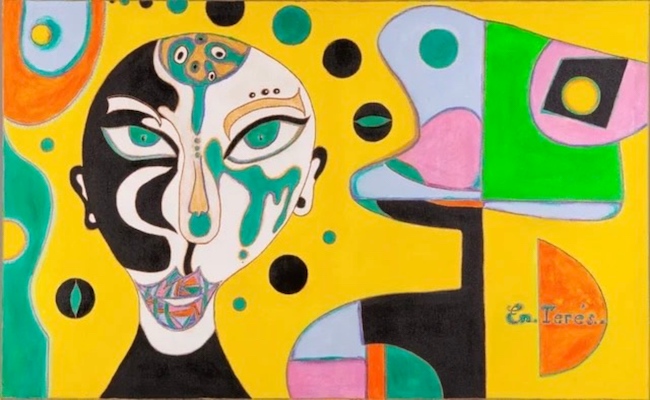La capacità di mescolare stili del passato per dar vita a linguaggi innovativi è una caratteristica privilegiata di molti artisti contemporanei che possono avvalersi delle conoscenze e delle sperimentazioni dei maestri del Novecento per elaborare qualcosa che attinga a essi pur generando un inedito approccio che non può non affascinare e conquistare l’osservatore. La protagonista di oggi guarda il mondo attraverso il filtro poliedrico della sua natura vitale e positiva raffigurando personaggi e mondi sfaccettati quanto entusiasmanti.
Agli inizi del Novecento, tra i moti innovativi che scossero il mondo artistico dell’epoca al fine di distaccarsi dalla formalità espressiva e dal forte legame con la riproduzione della realtà così come osservata, si affermò uno dei movimenti più rivoluzionari che fece della scomposizione dell’immagine la sua principale linea guida. Il Cubismo, questo il nome della corrente di cui Pablo Picasso e George Braque furono teorici e massimi esponenti, anche se molti artisti da ogni parte d’Europa, tra cui Amedeo de Souza-Cardoso in Portogallo, Vilhelm Lundstrøm in Danimarca, Emanuil Popgenchev in Bulgaria, Juan Gris in Spagna, solo per citarne alcuni, scelsero di aderire a quel nuovo approccio creativo, segnò una vera e propria rivoluzione visiva poiché esplorava il visibile eliminando la terza dimensione e rappresentando simultaneamente differenti sfaccettature, tutti i lati della tridimensionalità riducendoli alla bidimensionalità. Da qui la necessità di scomporre l’immagine e portare ogni dettaglio in primo piano, definendone i lati e gli angoli geometricamente proprio perché osservati dal punto di vista logico, scientifico, sperimentale e di studio nei confronti di un’apparenza che non tenesse più conto dell’estetica dando invece prevalenza all’essenza, a un’osservazione nuova espressa attraverso una modalità non convenzionale eppure in grado di trasmettere una sua intensità. Per indagare i volti, gli oggetti, nella loro totalità immediata e poliedrica, una delle scelte di Picasso e di Braque fu quella di ridurre i colori a tonalità basiche, terrose, neutre per evitare che tinte più forti distraessero dall’intento scientifico e analitico che volevano suscitare nell’osservatore. La progressiva frammentazione delle forme indusse una parte degli artisti aderenti a distaccarsi dal Cubismo Analitico per andare verso un’astrazione rifiutata dai fondatori del movimento ma ricercata invece da Robert e Sonia Delauny che fondarono il Cubismo Orfico in cui la gamma cromatica divenne incredibilmente vivace e coinvolgente e l’aderenza alla realtà quasi inesistente. La medesima scelta coloristica, sebbene ampliata e adattata alla vitalità che appartiene alla sua natura e al suo istinto pittorico, contraddistingue l’artista russa Elena Tereshkova che però si lega fortemente alla rappresentazione della realtà, dunque senza rinunciare alla figurazione, più vicina al Cubismo Analitico pur stilizzandolo ulteriormente, o per meglio dire semplificando le immagini per raccontare una quotidianità, sensazioni ed emozioni ordinarie, che avvicinano l’osservatore al mondo fantastico e fiabesco caratteristico del Naïf.
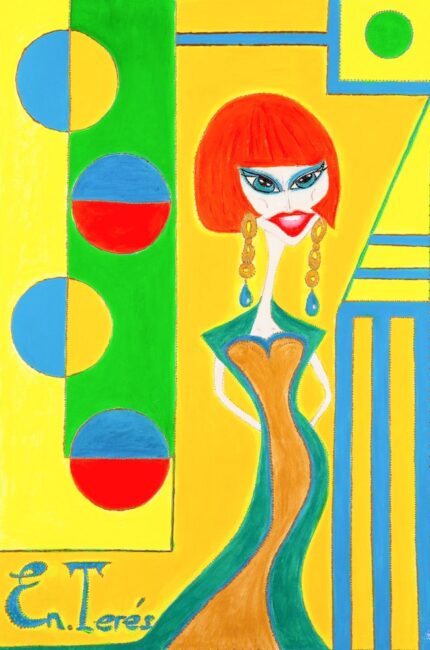
In un vivere contemporaneo incredibilmente complesso e a volte alienante, la Tereshkova avverte l’esigenza di ritrovare il contatto con la naturalezza e l’immediatezza delle emozioni più pure, semplici, ingenue quasi, ed è proprio questa tendenza a legarla nell’intento espressivo alle tematiche di uno stile, quello Naïf che guardava alla realtà in modo diretto, impulsivo, sognante, senza insinuarsi nei meandri della mente e dell’approccio scientifico bensì osservandola nella spontaneità del vivere.
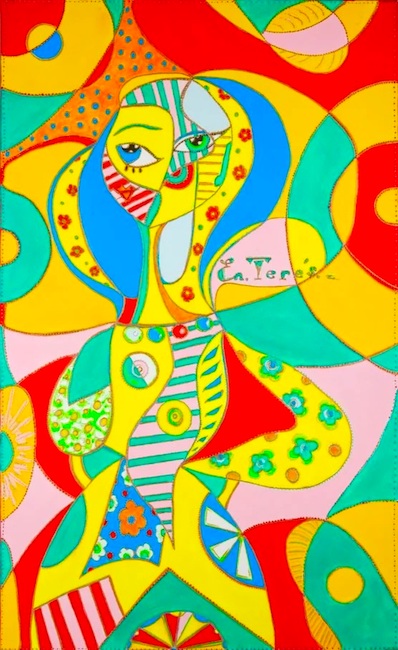
Elena Tershkova racconta di momenti di riflessione, di frangenti divertenti e di punti di vista positivi rispetto agli accadimenti, alle circostanze apparentemente ordinarie che sono però in grado di rendere la vita un cammino straordinario. I personaggi raffigurati dall’artista sono spontanei, ammiccanti, allegri, affrontano l’esistenza come se fosse un giardino ideale in cui cogliere i fiori delle sensazioni e delle emozioni da cui l’individuo non può prescindere.
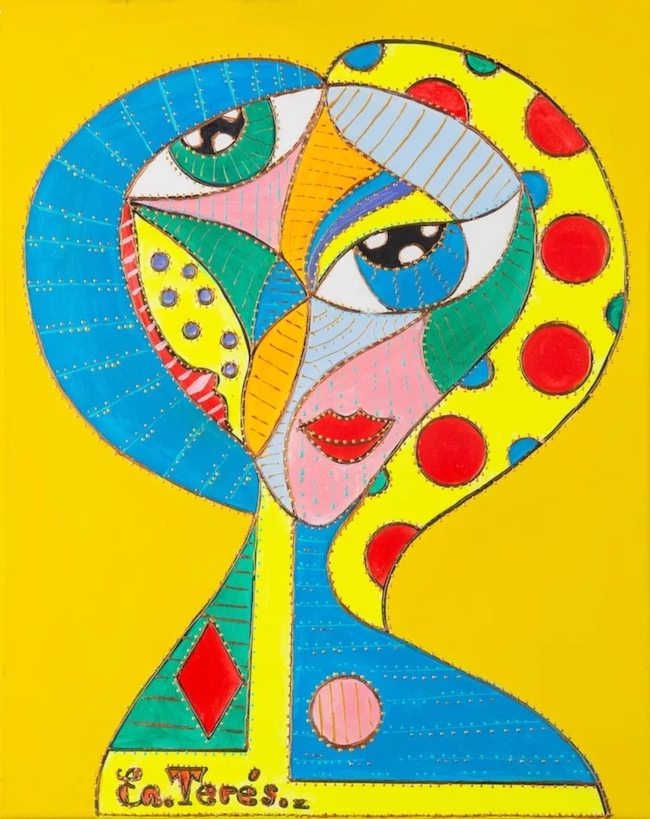
Nella tela Gente solare questo approccio vitale della Tereshkova emerge con tutta la sua luminosità, con tutta la capacità di evidenziare ciò che di bello e di piacevole si può ricevere dalla vicinanza con gli altri, con le persone che ruotano intorno alla vita di ciascuno e che sono in grado di migliorarne l’esistenza. Gli occhi sono intensi e avvolgenti, come se volessero trasmettere tutto l’affetto e l’empatia che dal contatto visivo si sprigiona, tutta la piacevolezza dell’incontrarsi che arricchisce l’alternarsi degli eventi, a volte più positivi altre volte meno, ma comunque parte di un cammino che tende all’evoluzione anche in virtù dell’incontro e della condivisione delle sensazioni che ne derivano.
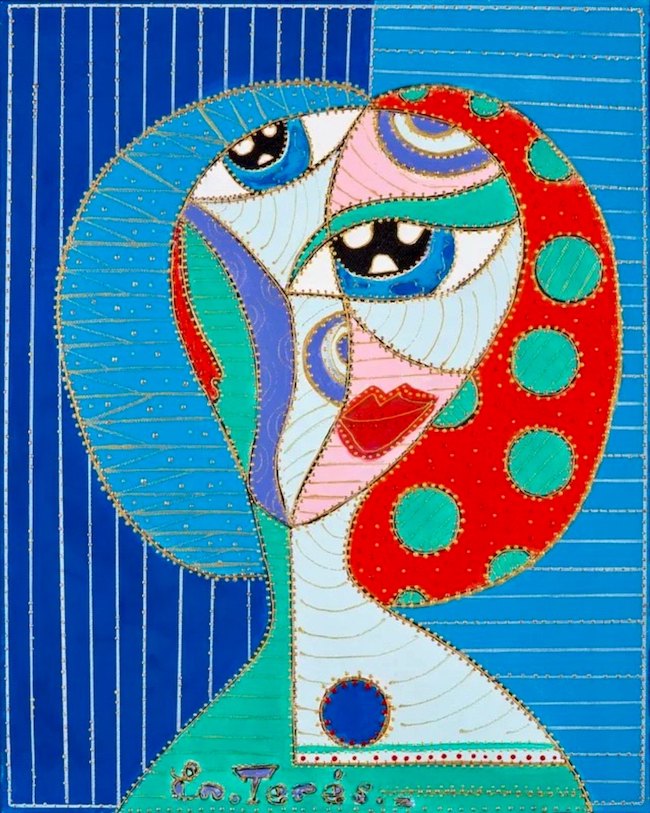
La medesima figurazione, ma declinata in tonalità differenti perché necessarie a evidenziare la delicatezza, talvolta trascurata, della sfaccettata personalità femminile è riprodotta nell’opera Le donne sono fiori, fiore Nontiscordardime dove il cromatismo volge verso i toni dell’azzurro in tutte le sue declinazioni, il colore della morbidezza, della nostalgia, del pensiero che spesso si perde dento i ricordi dolci di istanti trascorsi ma vivi perché chiusi all’interno dello scrigno emotivo; in questo caso gli occhi sono più emozionali, più introspettivi, quasi a voler far trasparire le riflessioni, la sensibilità e tutto ciò che troppo spesso viene invece tenuto nascosto, protetto dall’esterno o semplicemente messo in disparte davanti all’impellenza del vivere.

Nell’opera La vita è un piacere invece Elena Tereshkova si sposta verso il Cubismo Orfico, verso una maggiore astrazione attraverso la quale esprime la caleidoscopicità degli accadimenti, di quei frangenti di esistenza che vanno poi a comporre il puzzle della personalità, delle tinte forti da cui a volte ci si sente travolti ma che in fondo costituiscono l’essenza e la sostanza di quel percorso accidentato ed entusiasmante che è la vita. È solo in virtù della capacità di intravedere il positivo anche all’interno di qualcosa di apparentemente avverso che tutto assume un aspetto differente permettendo di tendere alla crescita e all’evoluzione nella consapevolezza che anche quell’ostacolo ha costituito un importante passo verso la conoscenza di sé e della propria forza; ecco dunque che i pois, le righe, le forme curve, accese dai colori pieni e decisi, rappresentano proprio quel necessario alternarsi degli eventi, quel cadere e poi rialzarsi che rende tutto più vivo e affascinante.

Il dipinto Io e te costituisce il coronamento del pensiero della Tereshkova, quell’incontrarsi e stringersi in un abbraccio avvolgente, abbandonandosi l’uno all’altra e continuare insieme, come coppia, il percorso di approfondimento e di conoscenza di se stessi attraverso il confronto con l’altro che rappresenta un arricchimento malgrado la diversità, una comprensione della necessità di trovare un completamento di sé oltrepassando quelle differenze funzionali a mettersi in discussione. La coppia è solida, la coppia permette di affrontare le vicissitudini insieme, superandole insieme e proprio in virtù di questa tensione esistenziale, costruire un rapporto via via più stabile dove l’uno diviene sostegno dell’altro, dove la parte più forte è a sua volta supportata dalla morbidezza e dalla dolcezza di quella apparentemente più fragile ma non per questo meno salda o necessaria. Il volto reclinato della donna ricorda da un lato le figure di Picasso ma dall’altro l’iconica immagine de Il bacio di Gustav Klimt in cui è chiaramente espresso un abbraccio passionale di incredibile impatto emotivo; medesima intensità è quella che fuoriesce dalla tela di Elena Tereshkova, a conferma, se mai ve ne fosse bisogno, di quanto l’immediatezza e la semplicità descrittiva non rinunci alla forza comunicativa in grado di avvolgere l’osservatore.
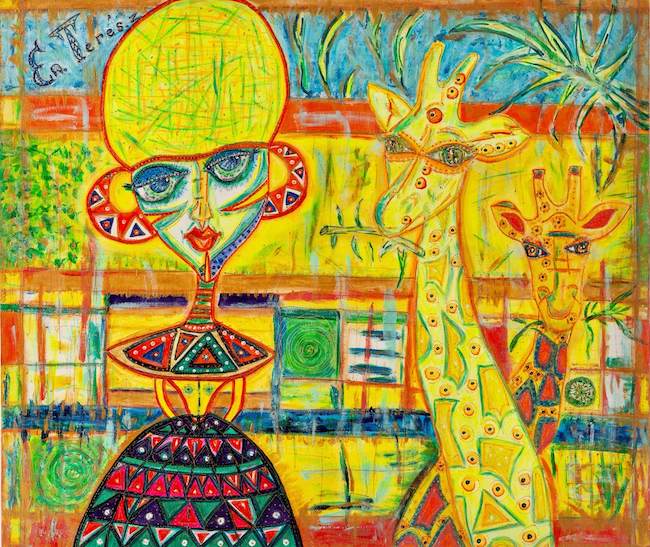
Elena Tereshkova ha al suo attivo molte mostre collettive in Lituania, Corea, Italia, Svizzera, Cina, India, Equador, Turchia, Filippine, Corea del Sud, Norvegia, Perù, Emirati Arabi, Russia, Francia, Argentina, Messico, Germania, Pakistan, Marocco, Romania, Nepal, Regno Unito, Spagna, Ungheria, Stati Uniti, e alcune sue opere sono esposte in permanenza in due musei della Corea del Sud e nel Museo Galleria di Arte Moderna e Contemporanea delle Filippine.
ELENA TERESHKOVA-CONTATTI
Email: 93.cosmos@gmail.com
Facebook: https://www.facebook.com/profile.php?id=100040483670123
Instagram: https://www.instagram.com/elena_teres_art/
Elena Tereshkova’s brightly coloured universe, between Cubism and Naïf
The ability to mix styles from the past to create innovative languages is a privileged characteristic of many contemporary artists who can make use of the knowledge and experiments of the masters of the twentieth century to develop something that draws on them while generating a new approach that cannot fail to fascinate and win over the observer. Today’s protagonist looks at the world through the multifaceted filter of her vital and positive nature, depicting characters and worlds that are as multifaceted as thrilling.
At the beginning of the 20th century, among the innovative movements that shook the artistic world of the time in order to break away from expressive formality and the strong link with the reproduction of reality as observed, emerged one of the most revolutionary movements that made the decomposition of the image its main guideline. Cubism, the name of the movement of which Pablo Picasso and George Braque were theorists and leading exponents, although many artists from all over Europe, including Amedeo de Souza-Cardoso in Portugal, Vilhelm Lundstrøm in Denmark, Emanuil Popgenchev in Bulgaria and Juan Gris in Spain, just to name a few, chose to adhere to this new creative approach, which marked a real visual revolution as it explored the visible by eliminating the third dimension and simultaneously representing different facets, all sides of three-dimensionality reducing them to two-dimensionality. Hence the need to break down the image and bring every detail to the foreground, defining its sides and angles geometrically precisely because they were observed from a logical, scientific, experimental point of view and a study of an appearance that no longer took account of aesthetics, giving prevalence instead to the essence, to a new observation expressed through an unconventional method that was nevertheless able to convey its own intensity.
In order to investigate faces and objects in their immediate and multifaceted totality, one of Picasso’s and Braque’s choices was to reduce colours to basic, earthy, neutral shades to prevent stronger colours from distracting from the scientific and analytical intent they wanted to arouse in the observer. The progressive fragmentation of forms led some of the artists who adhered to the movement to move away from Analytical Cubism towards an abstraction rejected by the movement’s founders but sought out by Robert and Sonia Delauny who founded Orphic Cubism in which the range of colours became incredibly vivid and engaging and the adherence to reality almost non-existent. The same colouristic choice, although enlarged and adapted to the vitality that belongs to her nature and her pictorial instinct, distinguishes the Russian artist Elena Tereshkova who, however, is strongly linked to the representation of reality, therefore without renouncing figuration, closer to Analytical Cubism although stylizing it further, or rather simplifying the images to tell of an everyday life, ordinary sensations and emotions, which bring the observer closer to the fantastic and fairy-tale world characteristic of Naïf. In a contemporary living that is incredibly complex and sometimes alienating, Tereshkova feels the need to rediscover contact with the naturalness and immediacy of the purest, simplest, almost ingenuous emotions, and it is precisely this tendency that binds her expressive intent to the themes of a style, the Naïf one, which looked at reality in a direct, impulsive, dreamy way, without creeping into the meanders of the mind and the scientific approach but observing it in the spontaneity of living. Elena Tershkova tells of moments of reflection, amusing moments and positive points of view regarding events, apparently ordinary circumstances that are able to make life an extraordinary journey.
The characters portrayed by the artist are spontaneous, winking, cheerful, they face existence as if it were an ideal garden in which to pick the flowers of sensations and emotions from which the individual cannot disregard. In the painting Sunny People, Tereshkova’s vital approach emerges in all its brilliance, with all her ability to highlight what is beautiful and pleasant about being close to others, to the people who revolve around one’s life and who are able to improve it. The eyes are intense and enveloping, as if they wanted to convey all the affection and empathy that emanates from eye contact, all the pleasantness of meeting each other that enriches the alternation of events, sometimes more positive and sometimes less so, but nevertheless part of a journey that tends towards evolution also by virtue of the meeting and the sharing of the resulting sensations. The same figuration, but in different tones because they are necessary to highlight the delicacy, sometimes overlooked, of the multi-faceted female personality, is reproduced in the painting Le donne sono fiori, Nontiscordardime flower, where the colour scheme turns towards shades of blue in all its forms, the colour of softness, nostalgia, of the thought that is often lost in the sweet memories of moments that have passed but are still alive because they are closed inside the emotional treasure chest; in this case the eyes are more emotional, more introspective, as if to reveal the reflections, the sensitivity and everything that is all too often kept hidden, protected from the outside world or simply put aside in the face of the urgency of life. In La vita è un piacere (Life is a pleasure) Elena Tereshkova moves towards Orphic Cubism, towards a greater abstraction through which she expresses the kaleidoscopic nature of events, of those moments of existence that then go on to compose the puzzle of the personality, of the strong colours by which we sometimes feel overwhelmed but which in the end constitute the essence and substance of that bumpy and exciting path that is life.
It is only by virtue of the ability to glimpse the positive even within something apparently adverse that everything takes on a different aspect, allowing us to strive for growth and evolution in the knowledge that even that obstacle has constituted an important step towards self-knowledge and strength; hence the polka dots, stripes, curved shapes, lit up by full and bold colours, represent precisely that necessary alternation of events, that falling and then getting back up that makes everything more alive and fascinating. The painting Io e te (Me and you) constitutes the crowning achievement of Tereshkova’s thought, that of meeting and tighten in an enveloping embrace, abandoning oneself to the other and continuing together, as a couple, on the path of deepening and getting to know oneself through the comparison with the other, which represents an enrichment despite the diversity, an understanding of the need to find a completion of oneself, going beyond those differences that serve to question oneself. The couple is solid, the couple makes it possible to face vicissitudes together, overcoming them together, and precisely because of this existential tension, to build a relationship that is gradually more stable, where one becomes the support of the other, where the stronger part is in turn supported by the softness and sweetness of the apparently more fragile part, which is no less solid or necessary. The reclining face of the woman is reminiscent on the one hand of Picasso’s figures, but on the other of the iconic image of Gustav Klimt’s The Kiss, in which a passionate embrace of incredible emotional impact is clearly expressed; the same intensity is evident in Elena Tereshkova’s canvas, confirming, if ever there was a need, how immediacy and descriptive simplicity do not renounce the communicative force capable of enveloping the observer. Elena Tereshkova has had many group exhibitions in Lithuania, Korea, Italy, Switzerland, China, India, Ecuador, Turkey, Philippines, South Korea, Norway, Peru, United Arab Emirates, Russia, France, Argentina, Mexico, Germany, Pakistan, Morocco, Romania, Nepal, United Kingdom, Spain, Hungary, United States, and some of her artworks are permanently exhibited in two museums in South Korea and in the Museum Gallery of Modern and Contemporary Art in the Philippines.


